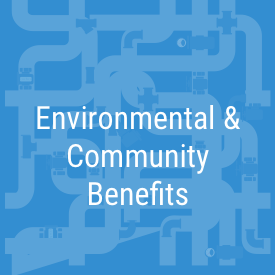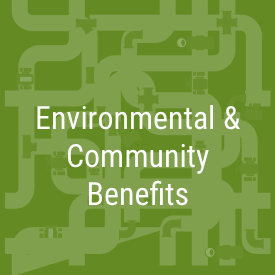The Good Neighbor Program encompasses Valley Water’s efforts to address the effects of encampments of unsheltered people located on property where Valley Water owns land rights, which spans approximately 333 of the more than 800 miles of creeks and waterways in Santa Clara County. Currently, more than 700 people are estimated to be living on Valley Water property and easements. Encampments commonly degrade water quality, obstruct fish passage and damage and destroy habitats on which these species depend. Not only is our environment being destroyed but our flood protection projects, and the people and neighborhoods they protect are at risk.
Valley Water’s past approach to encampment management was a complaint-driven, abatement-focused strategy. While this approach may have resulted in the temporary removal of an encampment, it rarely led to an outcome of fewer encampments overall, and often a removed encampment would move to a nearby location or move back to the original location, after it was cleaned. We can’t wait any longer to address this environmental and public safety crisis in our creeks.
In recent years, federal case law has significantly affected how Valley Water responds to encampments of unsheltered people. Federal court decisions require that shelter or other housing solutions be offered before unsheltered people may be relocated from public lands. Given the unprecedented need for transitional and long-term housing in Santa Clara County, there is currently only shelter capacity for approximately one-quarter of the unsheltered population. For this reason, there is often little that Valley Water can do to relocate encampments until there are sufficient housing alternatives. To help be a part of the regional solution to this crisis, Valley Water has offered up property away from the creeks for potential safe sleeping sites.
Currently, Valley Water uses a variety of tools and approaches to better manage sites and reduce the need for cleanup of the waterways and the species that depend on them until adequate housing is available. Valley Water will continue to work with our partners and assist in their efforts to find solutions to address unsheltered homelessness. Valley Water is not a law enforcement agency, we lack police powers and land use authority, meaning we cannot provide law enforcement or housing services, but we are committed to using the resources we have as an environmental stewardship agency to protect our waterways in collaboration with cities and the County as they fulfill their public safety and human service roles. Valley Water crews continue to perform large scale trash cleanups throughout areas countywide to prevent encampment-generated trash, debris, and hazardous pollutants from polluting our waterways.








Valley Water Board of Directors postpones decision on proposed ordinance to reduce encampments along creeks, waterways and water supply facilities
At its meeting on July 9, 2024, Valley Water’s Board of Directors postponed a decision on a proposed ordinance to reduce encampments, prevent re-encampments and prohibit related activities along creeks, waterways, water supply facilities and other lands where Valley Water holds land rights.
The Board of Directors sent the ordinance back to the Environmental Creek Cleanup Committee to review, incorporate comments and concerns from the public and board and provide clarity on the implementation process.
A planned summit to address the impacts of encampments in waterways is scheduled for Oct. 11, 2024. Valley Water hopes to bring together local leaders from Santa Clara County, South Bay cities, businesses, nonprofit groups, and advocacy organizations to discuss addressing unsheltered encampments in waterways, actionable ideas for collaboration, and working together towards real solutions.
The proposed Water Resources Protection Zones ordinance is designed to help protect water resources, endangered species and other ecological resources. It is also intended to support and improve safety for Valley Water’s staff working in the field, who have faced increase armed threats of violence, verbal assaults and physical intimidation, vicious dog encounters and fire-related occurrences.
Valley Water’s intention of this proposed ordinance is not to result in criminalization of the unhoused community. This ordinance is designed to first employ an educational approach to obtain compliance with the ordinance and existing laws. Valley Water does not want to see people incarcerated or fined because of this ordinance. Our goal is to create safer conditions for our staff who work in and around creeks, waterways and water supply facilities and better protect the environment and infrastructure.
Creek Owner Obligations
There is not a singular entity in charge of the waterways. Valley Water owns and manages 295 miles of the more than 800 miles of creeks and rivers in Santa Clara County, and the remaining stretches of creeks are owned by Santa Clara County, private entities, cities in which the creeks are located, and other public agencies. Property owners whose land extends into the creek have a primary role in maintaining their Creekside land.
Valley Water performs encampment management activities only on the property where it possesses land rights or where it has built flood protection projects. Management of encampments on land owned by other entities is the responsibility of those entities. This fact sheet identifies Valley Water’s role in stream maintenance.
For reference, the map below shows Valley Water-owned lands in green.
Enhanced Cleanups
Valley Water’s encampment cleanup crews operate daily at locations throughout the county. Our crews leave encampments in place to the extent possible—clearing encampment-generated trash, debris, and hazardous pollutants and providing advance notice to encampment residents through 72-hour posting. Valley Water also conducts encampment weed abatement to reduce the risk of wildfire, with the same 72-hour notice.
How do I find out when an area will be cleaned next?
The map below identifies recent and planned cleanups and statistics for regularly scheduled cleanup sites.
You can report encampment-related concerns to Valley Water via our online system at: https://access.valleywater.org/s/.
Encampment Resolution Protocol
Valley Water will abate encampments under limited circumstances to enable our staff to conduct water district business. We also defer to cities to determine when issues of public safety might necessitate abatement of encampments on our land, and we rely on them to communicate those issues to us.
When performing work critical to its core mission, Valley Water will abate encampments located on Valley Water property, including Valley Water right-of-way, through coordinated efforts with other public agencies if the following criteria are met:
- The encampment is in the path of or obstructing access to
- flood protection/water infrastructure facilities or projects
designated mitigation or vegetation management sites; or
- The encampment poses an immediate safety risk, including situations that involve staff safety or public safety issues, which can be determined by municipal agencies or their police or fire departments.
If a city or the County determines that an encampment on Valley Water property needs to be abated due to trail safety, public health, and/or criminal activity, Valley Water staff would support clean-up operations at the site, with assistance from our city partners to post the encampment for cleanup and removal. However, if cities and law enforcement do not support abatement, Valley Water cannot conduct these activities on its own because our governing District Act does not provide Valley Water with police powers. Because Valley Water is not a law enforcement agency, nor do we provide direct homelessness/housing services, we rely on city or County assessments regarding whether public safety issues necessitate the removal of a particular encampment. In the case of a public safety issue, Valley Water will assist local jurisdictions in addressing encampments on property where Valley Water holds land rights.
To assess encampments that do not meet the above criteria, but still pose a heightened risk to the environment, staff safety, or public safety Valley Water will conduct Water Resources Risk Assessments. Through this process, Valley Water staff documents risks that an encampment may pose to Valley Water facilities or operations. An assessment of the totality of these risk factors helps determine whether abatement of a particular encampment may be warranted. This process assists Valley Water to ensure the protection of natural resources, water quality, and the health and safety of employees and the public who use Valley Water land, facilities, and waterways.
When abatement is warranted, Valley Water staff follows a protocol that includes:
- Posting the encampment for cleanup and removal
- Providing a minimum of 72-hours notice prior to abatement
- Requesting that outreach providers visit the encampment to offer services and/or available housing or shelter options.
Good Neighbor Program Funding & Initiative
The Good Neighbor Program’s operations are funded under the Safe, Clean Water and Natural Flood Protection Program project F5: Good Neighbor Program: Encampment Cleanup. When the Safe, Clean Water Program was renewed by voters in 2020, the Encampment Cleanup project budget was increased to $38.7 million over 15 years. Starting in Fiscal Year 2024-2025, for additional work beyond what is funded by the Safe, Clean Water Fund, a new Encampment Management project will be established with funding from an existing ad valorem property tax revenue stream that makes up Valley Water’s Watershed & Stream Stewardship Fund.
To supplement Valley Water’s Good Neighbor encampment cleanups, in Fiscal Year 2023-2024, the Board voted to support two new programs that will further protect the environment along our waterways.
- The Portable Toilet Facilities Program provides portable toilets and wash stations at critical locations along local creeks to reduce biowaste entering the waterways.
- The Clean Camps, Clean Creeks Program will be rolled out soon to provide reloadable pre-paid cards that will incentivize unsheltered residents on Valley Water lands to maintain tidy camp areas free of trash. The intent of this program is to work together with the encampment residents to reduce the amount of encampment-generated trash, debris, and hazardous pollutants that enters the waterways.
Case Law Limitations
A 2019 court ruling by the 9th Circuit Federal Court of Appeals in the case of Martin v. Boise has limited the ability of public agencies, including Valley Water, to relocate unsheltered individuals who are camping on public lands. This ruling holds that governments in the court’s jurisdiction (which includes California) cannot criminalize sleeping outdoors on public property if there is no real option for sleeping indoors. Shelter is required to be offered before unsheltered people may be cited for sleeping on public lands.
Valley Water's Authority under State Assembly Bill 1469
Assembly Bill 1469 amends the Santa Clara Valley Water District Act to give Valley Water the authority to assist unsheltered people living along streams, in riparian corridors, or otherwise in its jurisdiction, in consultation with a city or the County of Santa Clara, to provide solutions or improve outcomes for the unsheltered individuals. Specifically, the law allows Valley Water the flexibility to use district land and a part of an existing ad valorem property tax for lasting encampment solutions. The intent is to work with local cities or the County to construct low-barrier navigation centers, supportive housing, transitional housing, affordable housing, or other facilities to assist unsheltered people. These facilities may be operated by a city, the County, or a non-profit with the appropriate expertise to provide shelter and services that can improve outcomes for unsheltered people. Valley Water sought this authority from the state to protect water resources and habitat while also complying with federal case law regarding encampments of unsheltered people on public lands.
Board Oversight
Environmental Creek Cleanup Committee (formerly known as the Homeless Encampment Committee) was established to discuss homelessness and encampment issues and bring discussion and recommendations back to the Board.
Benefits
- Reduces the accumulation of trash, debris, and hazardous pollutants in local waterways, including streams, wetlands, and water utility facilities (e.g. groundwater ponds)
- Protects Valley Water facilities and reduces flood risk
- Improves the aesthetics of creeks in neighborhoods and along trails
- Coordinates Valley Water’s efforts with multiple agencies to create lasting solutions to reduce encampments near waterways
External Resources
- The Valley Water Board of Directors endorsed the 2020-2025 Community Plan to End Homelessness on May 25, 2021.
- BeautifySJ’s








